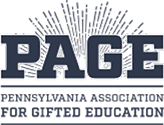Gifted Education in Pennsylvania Presentation Slides from the PA Dept of Education
Definitions of Giftedness
What is Giftedness?
Giftedness, intelligence, and talent are fluid concepts and may look different in different contexts and cultures. Even within schools you will find a range of beliefs about the word “gifted,” which has become a term with multiple meanings and much nuance.
Gifted children may develop asynchronously: their minds are often ahead of their physical growth, and specific cognitive and social-emotional functions can develop unevenly. Some gifted children with exceptional aptitude may not demonstrate outstanding levels of achievement due to environmental circumstances such as limited opportunities to learn as a result of poverty, discrimination, or cultural barriers; due to physical or learning disabilities; or due to motivational or emotional problems. This dichotomy between potential for and demonstrated achievement has implications for schools as they design programs and services for gifted students.
NAGC does not subscribe to any one theory of the nature of human abilities or their origins. We assert that there are children who demonstrate high performance, or who have the potential to do so, and that we have a responsibility to provide optimal educational experiences to fully develop talents in as many children as possible, for the benefit of the individual and the community.
Definitions of Giftedness
Definitions provide the framework for gifted education programs and services and guide key decisions such as which students will qualify for services, the areas of giftedness to be addressed in programming (e.g., intellectual giftedness generally, specific abilities in math), when the services will be offered, and even why they will be offered. There is no universally accepted definition of giftedness.
National Association for Gifted Children
“Gifted individuals are those who demonstrate outstanding levels of aptitude (defined as an exceptional ability to reason and learn) or competence (documented performance or achievement in top 10% or rarer) in one or more domains. Domains include any structured area of activity with its own symbol system (e.g., mathematics, music, language) and/or set of sensorimotor skills (e.g., painting, dance, sports).”
State Definitions of Gifted and Talented
Nearly every state has its own definition of gifted and talented students. Some define giftedness based on a comparison to others of the same age. Others base the definition on needs beyond what is offered in the regular classroom. Not all states require that school districts follow the state definition.
Compare the state definitions.
Federal Definition of Gifted and Talented
“The term ‘gifted and talented,” when used with respect to students, children, or youth, means students, children, or youth who give evidence of high achievement capability in such areas as intellectual, creative, artistic, or leadership capacity, or in specific academic fields, and who need services or activities not ordinarily provided by the school in order to fully develop those capabilities.”
Prominent Theories of Giftedness
Among many theoretical conceptions of giftedness are those of Francoys Gagné and Joseph Renzulli. Others include Robert Sternberg’s Theory of Successful Intelligence and Howard Gardner’s Theory of Multiple Intelligences.
Gagné: The Differentiated Model of Giftedness and Talent proposes a clear distinction between giftedness and talent. In his model, the term giftedness designates the possession and use of untrained and spontaneously expressed natural abilities (called aptitudes or gifts) in at least one ability domain to a degree that places a child among the top 10% of his or her age peers. By contrast, the term talent designates the superior mastery of systematically developed abilities (or skills) and knowledge in at least one field of human activity to a degree that places a child’s achievement within the upper 10% of age-peers who are active in that field or fields. His model presents five aptitude domains: intellectual, creative, socio-affective, sensorimotor, and “others” (e.g. extrasensory perception). These natural abilities, which have a clear genetic substratum, can be observed in every task children are confronted with in the course of their schooling.
(Gagné, F. (1985). Giftedness and talent: Reexamining a reexamination of the definitions. Gifted Child Quarterly, 29, 103-112.)
Renzulli: Gifted behavior occurs when there is an interaction among three basic clusters of human traits: above-average general and/or specific abilities, high levels of task commitment (motivation), and high levels of creativity. Gifted and talented children are those who possess or are capable of developing this composite of traits and applying them to any potentially valuable area of human performance. As noted in the Schoolwide Enrichment Model, gifted behaviors can be found “in certain people (not all people), at certain times (not all the time), and under certain circumstances (not all circumstances).”
(Renzulli, J. S. (1978). What makes giftedness? Re-examining a definition. Phi Delta Kappa, 60, 180-181.)

